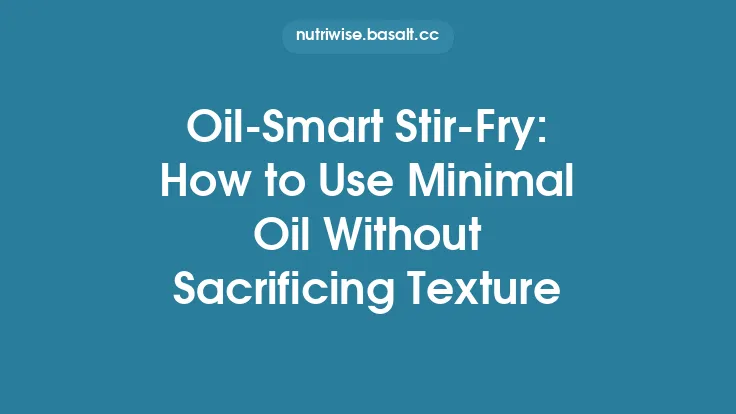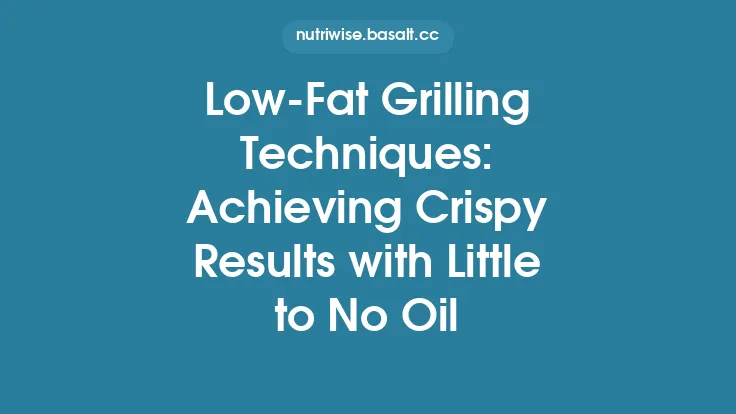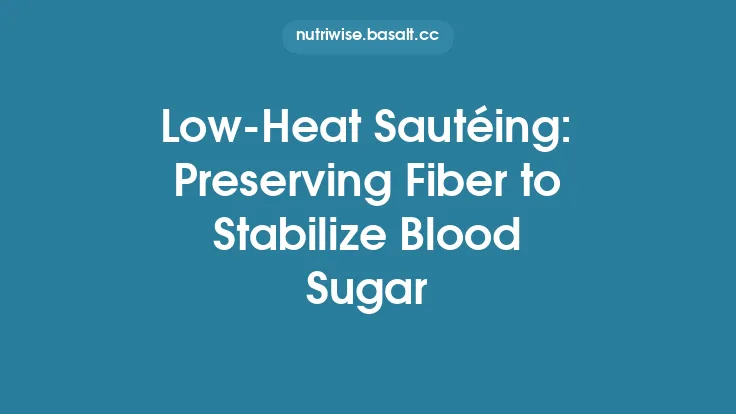Sautéing is a cornerstone technique in many kitchens, prized for its speed, flavor development, and versatility. When executed with a mindful approach—particularly by limiting the amount of oil used—sautéing can become a nutrient‑preserving method that aligns perfectly with health‑focused culinary practices. This article explores the science behind nutrient retention during sautéing, practical strategies for minimizing oil without sacrificing texture or taste, and tips for selecting the right cookware, fats, and ingredients to maximize the health benefits of this quick‑cook method.
Understanding the Nutrient Dynamics of Sautéing
Heat Transfer and Nutrient Stability
Sautéing typically involves cooking food in a thin layer of fat over medium‑high heat for a short period (usually 2–8 minutes). The rapid heat transfer raises the internal temperature of the food quickly, which can inactivate enzymes that would otherwise degrade vitamins and phytochemicals. However, excessive heat or prolonged exposure can lead to oxidation, leaching, or thermal breakdown of heat‑sensitive nutrients such as vitamin C, folate, and certain polyphenols.
The Role of Oil as a Heat Conductor
Oil serves two primary functions in sautéing: it raises the temperature of the cooking surface above the boiling point of water (100 °C/212 °F) and it creates a non‑stick barrier that reduces mechanical stress on delicate foods. Importantly, oil also acts as a carrier for fat‑soluble vitamins (A, D, E, K) and phytochemicals like carotenoids and flavonoids, enhancing their bioavailability. The key is to use just enough oil to achieve these benefits while avoiding excess that can dilute flavors and increase caloric load.
Oxidative Concerns
When oil is heated, especially beyond its smoke point, free radicals can form, potentially compromising both the oil’s nutritional profile and the food’s antioxidants. Selecting oils with higher oxidative stability (e.g., high‑oleic olive oil, avocado oil) and monitoring temperature closely are essential steps in preserving nutrients.
Choosing the Right Oil for Minimal‑Oil Sautéing
| Oil Type | Smoke Point (°C/°F) | Fatty Acid Profile | Best Uses in Minimal‑Oil Sauté |
|---|---|---|---|
| High‑Oleic Olive Oil | 210–220 °C / 410–428 °F | Predominantly monounsaturated (≈80 %) | Light sauté of vegetables, herbs, and lean proteins |
| Avocado Oil | 260 °C / 500 °F | Monounsaturated (≈70 %) + some polyunsaturated | High‑heat searing of meat or tofu with minimal oil |
| Refined Coconut Oil | 230 °C / 446 °F | Saturated (≈90 %) | Adds subtle flavor to Asian‑style sautéed dishes |
| Ghee (Clarified Butter) | 250 °C / 482 °F | Saturated + monounsaturated | Imparts buttery richness without water content that can cause steaming |
Why High‑Oleic Varieties Matter
High‑oleic oils contain a greater proportion of oleic acid, a monounsaturated fat that resists oxidation at cooking temperatures. This stability translates to fewer harmful aldehydes and a better preservation of both the oil’s own nutrients and those of the food being sautéed.
Techniques for Reducing Oil While Maintaining Moisture
- Pre‑Cooking Moisture Management
- Pat Dry: Excess surface water on vegetables or proteins creates steam, which can impede browning. Patting ingredients dry with a clean towel reduces the need for extra oil to achieve a crisp exterior.
- Partial Blanch (Optional): A brief, low‑temperature blanch (under 2 minutes) can soften tough fibers, allowing quicker browning with less oil. (Note: This is a minimal, optional step and not a full blanching process.)
- Deglazing with Low‑Calorie Liquids
After the initial sear, add a splash of broth, wine, or citrus juice to the pan. The liquid lifts fond (the caramelized bits) and creates a thin, flavorful coating that reduces the reliance on oil for flavor development. The liquid evaporates quickly, leaving a glossy surface that mimics the mouthfeel of a higher‑oil sauté.
- Utilizing Non‑Stick or Well‑Seasoned Cast Iron Pans
High‑quality non‑stick surfaces require as little as ½ teaspoon of oil for a full‑size skillet. Cast iron, when properly seasoned, forms a natural polymerized layer that behaves similarly to a non‑stick coating. Both options allow for even heat distribution and prevent food from sticking, minimizing the need for excess fat.
- Incorporating Aromatics Early
Adding minced garlic, ginger, or shallots at the start of the sauté releases volatile compounds that coat the food, enhancing flavor without additional oil. The aromatic oils from these ingredients also contribute a modest amount of healthy fats.
- Strategic Layering of Ingredients
Begin with denser, slower‑cooking items (e.g., carrots, onions) and add quicker‑cooking vegetables (e.g., bell peppers, spinach) later. This staggered approach ensures each component receives adequate heat exposure without the pan becoming overly saturated with moisture, which would otherwise necessitate more oil to achieve browning.
Temperature Control: The Sweet Spot for Nutrient Retention
- Medium‑High Heat (≈180–200 °C / 350–390 °F): This range is hot enough to induce Maillard reactions (browning) that develop flavor and lock in moisture, yet low enough to avoid surpassing most oil smoke points.
- Thermal Monitoring: Use an infrared thermometer or a simple “water droplet test” (a droplet should sizzle and evaporate within 1–2 seconds). Adjust the burner as needed to maintain consistent temperature throughout cooking.
Avoiding Over‑Cooking
Nutrients degrade most rapidly when exposed to high heat for extended periods. A rule of thumb: once the desired color is achieved, remove the food from the pan or lower the heat to finish cooking. This “quick‑finish” method preserves heat‑sensitive vitamins while still delivering a satisfying texture.
Maximizing the Bioavailability of Fat‑Soluble Nutrients
Many vegetables contain carotenoids (β‑carotene, lutein) and vitamin K, which are more readily absorbed in the presence of dietary fat. Even a modest amount of oil—about ½ teaspoon per serving—can dramatically increase absorption rates. To keep oil usage minimal yet effective:
- Add Oil at the End: Drizzle the measured oil over the finished dish and toss briefly. The residual heat is sufficient to emulsify the oil, coating the food without additional cooking time.
- Combine with Natural Fat Sources: Incorporate small amounts of nuts, seeds, or avocado slices after sautéing. These provide additional monounsaturated and polyunsaturated fats that aid nutrient uptake without requiring extra cooking oil.
Practical Recipe Frameworks
1. Minimal‑Oil Sautéed Leafy Greens
- Ingredients: 2 cups kale, 1 cup spinach, ½ teaspoon high‑oleic olive oil, 1 clove garlic (minced), pinch of sea salt, squeeze of lemon.
- Method: Heat a non‑stick skillet over medium‑high. Add garlic and oil; sauté 30 seconds. Add kale, stirring constantly for 2 minutes. Add spinach, continue stirring for another 1 minute until wilted. Remove from heat, season, and finish with lemon juice.
*Result*: The brief oil exposure delivers enough fat for lutein absorption while preserving vitamin C and folate.*
2. Protein‑Focused Minimal‑Oil Sauté (Chicken Breast)
- Ingredients: 150 g skinless chicken breast, ½ teaspoon avocado oil, ¼ cup diced onion, ¼ cup sliced mushrooms, herbs (thyme, rosemary).
- Method: Pat chicken dry, season with salt and pepper. Heat a well‑seasoned cast‑iron skillet to medium‑high. Add oil, swirl to coat. Place chicken, sear 3 minutes per side until golden. Remove, set aside. Add onion and mushrooms, sauté 2 minutes, deglaze with 2 Tbsp low‑sodium broth, return chicken to pan, cover, and finish for 2 minutes.
*Result*: The oil amount is sufficient for Maillard browning and flavor development, while the quick deglazing step adds moisture and reduces the need for additional fat.*
3. Vegetable Medley with Nutrient‑Boosting Finish
- Ingredients: ½ cup sliced carrots, ½ cup broccoli florets, ½ cup red bell pepper, ½ teaspoon refined coconut oil, 1 Tbsp toasted sesame seeds, 1 tsp soy‑ginger glaze (low‑sodium).
- Method: Heat a non‑stick skillet over medium. Add oil, then carrots; sauté 2 minutes. Add broccoli and bell pepper; continue 3 minutes, stirring frequently. Remove from heat, drizzle glaze, toss, and sprinkle sesame seeds.
*Result*: The minimal oil enables crisp‑tender vegetables, while the sesame seeds provide additional healthy fats for the absorption of carotenoids.*
Common Pitfalls and How to Avoid Them
| Pitfall | Consequence | Solution |
|---|---|---|
| Overcrowding the pan | Steaming instead of browning; nutrient loss through excess moisture | Cook in batches or use a larger skillet; ensure a thin, even layer of food |
| Heating oil past its smoke point | Formation of harmful compounds; degradation of oil’s nutrients | Choose high‑smoke‑point oils; monitor temperature; add food before oil reaches smoke |
| Using too much oil for “flavor” | Unnecessary calories; dilution of natural food flavors | Rely on aromatics, herbs, and deglazing liquids for flavor; reserve oil for texture and nutrient absorption |
| Ignoring the “rest” period after sauté | Continued cooking can over‑soften vegetables, leading to nutrient leaching | Remove food promptly once desired color/texture is reached; let rest on a warm plate for a minute before serving |
The Science of Maillard Reactions and Nutrient Preservation
The Maillard reaction—a complex series of chemical interactions between amino acids and reducing sugars—creates the browned, savory flavors we associate with sautéed foods. While this reaction occurs at temperatures above 140 °C (284 °F), it does not inherently destroy nutrients; rather, it can enhance the palatability of nutrient‑dense foods, encouraging higher consumption. However, excessive Maillard activity can generate advanced glycation end products (AGEs), which have been linked to inflammation when consumed in large amounts. By limiting cooking time and maintaining moderate heat, you can reap the flavor benefits while keeping AGE formation low.
Integrating Minimal‑Oil Sauté into a Balanced Diet
- Portion Control: Even with reduced oil, portion sizes matter. Pair sautéed vegetables with whole grains, legumes, or lean proteins for a complete meal.
- Complementary Cooking Methods: While this article focuses on sautéing, you can combine it with other nutrient‑preserving techniques (e.g., finishing a roasted sweet potato with a quick sauté of greens) to diversify textures and nutrient profiles.
- Seasonal Ingredient Selection: Fresh, in‑season produce typically contains higher levels of vitamins and phytochemicals, making the most of the nutrient‑preserving benefits of minimal‑oil sauté.
Quick Reference Checklist for Nutrient‑Preserving Sauté
- [ ] Choose high‑oleic or high‑smoke‑point oil; measure precisely (½–1 tsp).
- [ ] Pre‑dry ingredients to reduce steam.
- [ ] Pre‑heat pan to medium‑high; verify temperature with a droplet test.
- [ ] Use non‑stick or well‑seasoned cast iron to minimize sticking.
- [ ] Add aromatics early; deglaze with low‑calorie liquid if needed.
- [ ] Monitor color; remove from heat as soon as desired browning is achieved.
- [ ] Finish with a brief toss of oil or natural fat source for nutrient absorption.
- [ ] Serve immediately to preserve heat‑sensitive vitamins.
By adhering to these principles, sautéing transforms from a simple cooking shortcut into a deliberate, health‑forward technique that respects the integrity of the foods we love. The result is a plate that is flavorful, visually appealing, and nutritionally robust—all achieved with a modest amount of oil and a mindful approach to heat.





